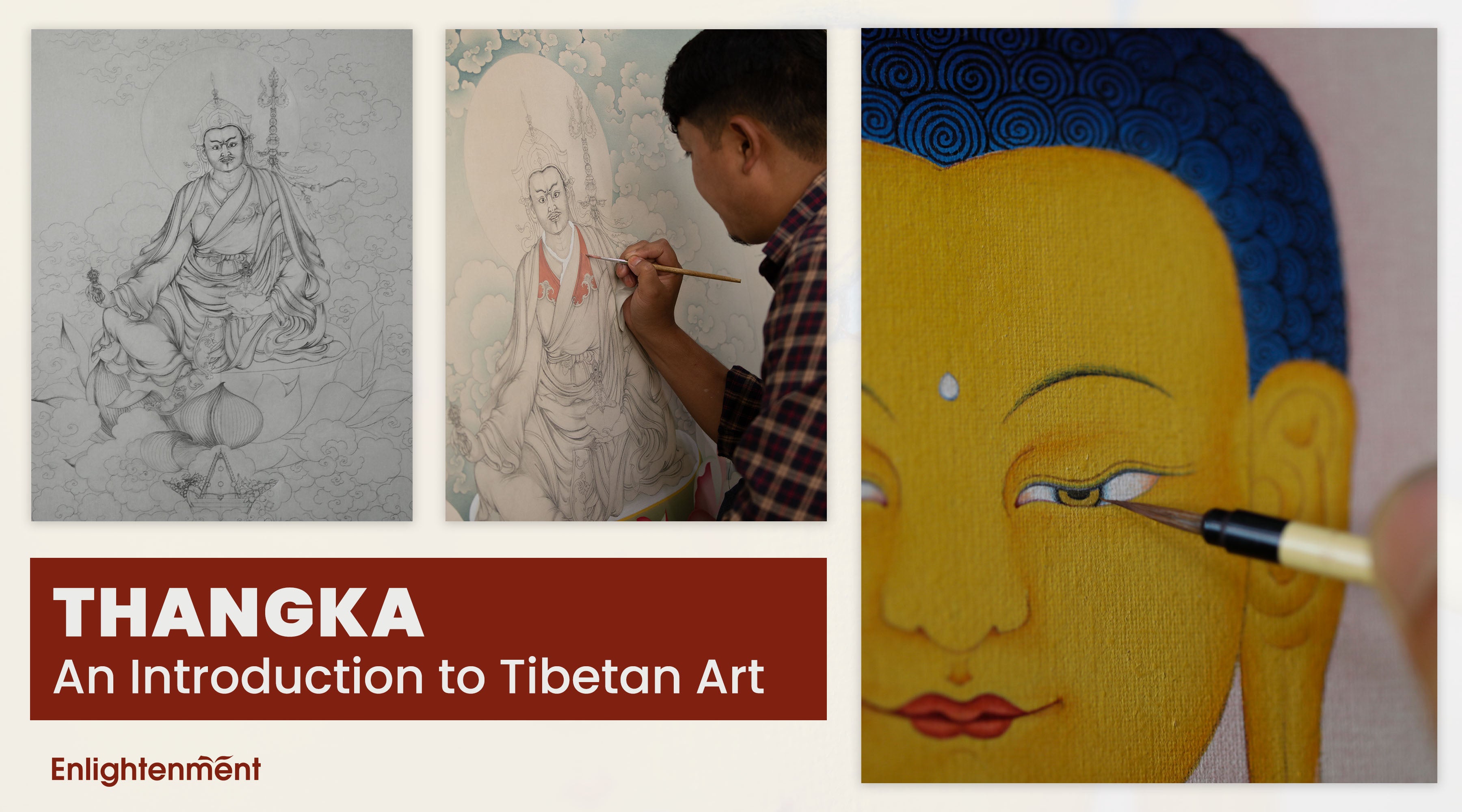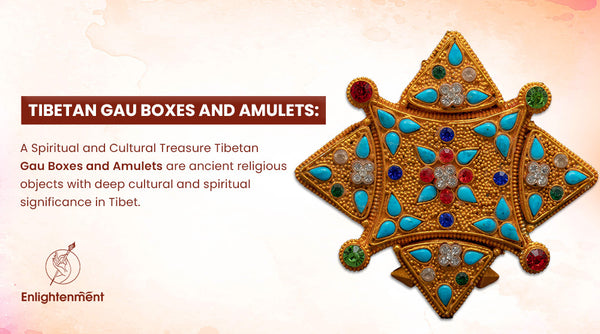What is a Thangka?
- Used as tool for visualization while meditating
- Teach student and monks
- Describe various historical events associated with Buddhism
- Used during ceremonies while offering prayers
However, the most important aspect of thangka art is that it offers a valuable manifestation of the deity. By stimulating the visualization during meditation, thangka is very helpful for the Buddhist practitioners.
Importance of Thangka in Tibetan Buddhism
“They take something that is in its essence beyond the form, but reveals itself in visionary forms, adapted to our earthly ability for visualization and conceptualization.”
In the practice of Buddhist art, the proper creation of supreme images is the accumulation of merit, and the accompanying attitude and motivation is the accumulation of wisdom. Because of the sanctity of the origin of the deities' measurements and proportions, any adjustments or alterations to the tradition are allowed to only someone with higher realizations and knowledge of the profound meanings.
Origin of the Thangka Painting
So what makes the Thangka, A Sacred Art?
"Sacred art is not just a representation of symbols and ideas. It is a direct experience of inner peace, free from attachment to the illusory solidity of the ego and the phenomenal world."
Fundamental Concepts of Thangka Paintings
The Traditional Thangka Painting is believed to be strung together with tradition. So, the common knowledge is the thangka’s tendency to disallow any ample artistic freedom. That is not to say that there isn’t room for exploring aesthetics and showcasing creativity.
The stylistic variations and artistic liberty within the parameters of the given traditional structure are appreciated. There is plenty of space for full creative expression since many of the figures are illustrated from personal mystical visions of the Buddhist saints.
The important thing is to establish the almost spiritual connection between the artist and the painting early on. No two paintings are the same by this virtue, even if they are copied. Each has a life of its own. Every time the artist handles a brush, there comes a different style and a new aspect. It is an enigma in itself. New ideas hence take form like pearls in the infinite ocean of creativity. Be it traditional art or modern art, the fact remains that an artist ‘creates’ and ‘communicates’ through the act of applying a brush to a canvas.
 Click here for High-quality Thangka prints.
Click here for High-quality Thangka prints.
And so, each form of art, no matter how it is classified, becomes an artist’s expression. There are different types of thangkas.
Types of Thangka
- Regular (multicolored) Thangka
- Black Thangka
- Gold Thangka
- Red Thangka.
Regular Thangka:
Regular Thangkas are the most common ones found and being practiced by artists all over the globe. They have gained popularity over time through their simplistic yet eloquent style and the use of a diverse color palette. The artist has the liberty to experiment with shades and hues, and depict the various deities or Buddhas by bringing their imagination to the canvas and using many different colors. There is a great deal of stylistic variation observed in these regular thangkas as it is easier to mix around and experiment with the colors and see what works best to an artist’s particular style. Not only is it beautiful but it is also very creative and gives the artist enough room for self-expression, communication, and learning.

Click here to view the collection of Buddha thangka
Black Thangka:
The Black Thangkas contrast the other types of thangkas with their rather unique features. The background is completely black, and the work is done almost exclusively in gold. Perhaps these specific color combinations are chosen because they represent the powerful aura of the wrathful deities. This is why these types of thangkas are used to depict the wrathful deities.

The most agreed upon the genesis of the Black Thangka says that the ashes of a holy lama were applied to a canvas and later a deity was drawn on in gold. There also exist black texts written in gold like kanjur and prajnaparamita. It is because it is widely accepted that this extensive use of gold, being such a pure substance, accumulates merit. Henceforth, there is every possibility that the Black Thangkas could have, in fact, originated after the black text.
Gold Thangka
To put it plainly, Gold Thangkas are not painted from an aesthetic perspective but rather completed only to earn merit on the part of the patron. It is because of the large amount of gold used in making the thangkas. It provides a similar context to that of Tibetans offering gold to paint the Jowo’s face in Lhasa and also painting the faces of statues in gold.
An interesting Eastern Tibetan parable speculates the origin of the Gold Thangka. It concerns a highly spiritual Lama who once invited two famous artists one from Chamdo, the other from Central Tibet, to paint his shrine room from him. The Lama showed them his shrine room where they discovered the walls were covered with gold paint. The Lama explained that some time previously, he had actually experienced a vision of radiant gold figures.
He recounted his vision to the artists and asked if they could recreate these figures upon his wall He stated the forms were to be created without the use of sketch work or the application of a single brush stroke upon the gold. The two conceived the idea to utilize the technique of burnishing the gold, executing the outlining and shading with this method. The work was so finely accomplished that t is said the figures were animated in appearance. The artists then being renowned as divine artists The Tibetan term for the work is 'Serku jazer ma', translating into Serku (Gold image) jazer ma (rainbow with radiant), gold images with the radiance of rainbows.

Red Thangka:
Red Thangka (dmar thang) is particularly used for peaceful deities. The red background here symbolizes the color of the body of the deity. Vajrapani is the red wrathful protector. Hence, the Thangka that depicts the red wrathful protector showcases the wrathful and ferocious qualities of the deity. Thangka that depicts this deity, illustrates the symbolical stamping of Maya or illusion or any attachment to earthly illusions. This is the inordinate symbolism of the color red that is used in this thangka.

Types of Figures in Thangka
In thangka painting, there are various types of figures that can be classified into these types:
- Peaceful Deity
- Semi-Wrathful Deity
- Wrathful Deity
- Worldly figures
Peaceful Figures
From the classifications of Dharmakaya, Sambhogakaya, and Nirmanakaya, the peaceful figures comprise the Buddhas and Bodhisattvas.
The peaceful Dharmakaya forms include Samantabhadra and Amitabha. The Sambhogakaya forms include Amitayus and Manjushri. And the Nirmanakaya forms include Padmasambhava. Even so, it is not always that they appear in peaceful forms – they can sometimes appear to be semi-wrathful or wrathful too.
 Click here to view our collection of Peaceful Bodhisattva Thangka.
Click here to view our collection of Peaceful Bodhisattva Thangka.
Semi-Wrathful Figures
The semi-wrathful figures fall between the spectrum of peaceful and fully wrathful beings.
They can be either female or male. Kalachakra, Vajrayogini, and Hevajra are included in the Istadevata figures. Vaishravana and Tenma Chuni are included in the Dharmapalas.
Padmasambhava is an ideal example of a mundane semi-wrathful being. The form is less muscular than fully-wrathful beings, especially the female renditions. They are portrayed with varying backgrounds and colors, including ornate decorations, shimmering nimbus, smoke, clouds, or even flames and wind. It essentially depends on the level and character of the individual figures.
 A perfect example of semi-wrathful figure in Thangka painting.
A perfect example of semi-wrathful figure in Thangka painting.
Wrathful Figures
The dharmapalas are the protectors of the dharma, so they are usually depicted in these types of figures, along with the occasional Istadevatas in wrathful forms.
For example, Vajrabhairava and Vajrakalika are the most common wrathful figures in the Gelupa and the Nyingmapa sect respectively. The wrathful figures appear in different forms, sizes, and expressions such as Yakshas, Rakshas, and Yamas. The wrathful deities wear the eight adornments. They also wear:
- Elephant skin
- Tiger skin
- Human skin
There are also the five serpents, diadems of five human skulls, a garland of fifty freshly severed human heads. The last two are the sun and moon on each shoulder, and blood, fat, and ash.

Worldly Figures:
The worldly figures are generally depicted in the human form with varied and unique characteristics and expressions. These figures include but aren’t limited to the peaceful, semi-wrathful, or wrathful idiosyncrasies. In this type of thangka, the artist is allowed the greatest degree of creative expression and freedom in painting the mundane or worldly features. Their aspects include short stature with a shorter neck and visible skeletal structure and muscle definition, giving them a certain uniqueness among other thangkas.
The general figures can be classified as semi-human figures who showcase different expressions of human forms. The most common figures are Devas, the gods, demi-gods, asuras, nagas and serpent, Garuda, Yakshas and Rakshas, preta, as well as demons. All of these figures in the classification of the Eight Classes of Gods and Demons, display some, if not a lot of human-like features, more or less partially. Hence, they are grouped into this category.



Another perfect example of Worldly figures is Jambala
Click here to view our Dzambala Thangka collection.
Iconography in Thangka
Depiction of Buddha in Thangka

The Forehead:
At a point, four small units below the hairline, in the center of the forehead, is the Urna or mid-brow point (mdzod, spu). Formed by thirty-two fine white hairs coiled to the right. It is drawn as a round dot with a diameter of one small unit.
The Eyes:
This band is traditionally yellow for peaceful divinities. And red and blue for the wrathful ones. The pupil is black, the eyeball veined with red. The eyes are clearly detailed, wide, and lovely. With the outer corners pointing towards the orifices of the ears.



6 comments
Ohio
Well done
Ohio
Well done
Ohio
Well done
DolmaTours
Wow, such great detail. I like your article. I want to read more about your blog. Thank you for sharing an amazing post.
Art of Tibet
Thangkas are amazing tool for meditation. Specially the Kalachakra ones. It gives me peace. Readers interested to know more about Kalachakra can visit: https://www.artoftibet.com/collections/kalachakra-mandala-thangka
Buddhists
This post is so peaceful to look at and learn. Thanks for posting :)